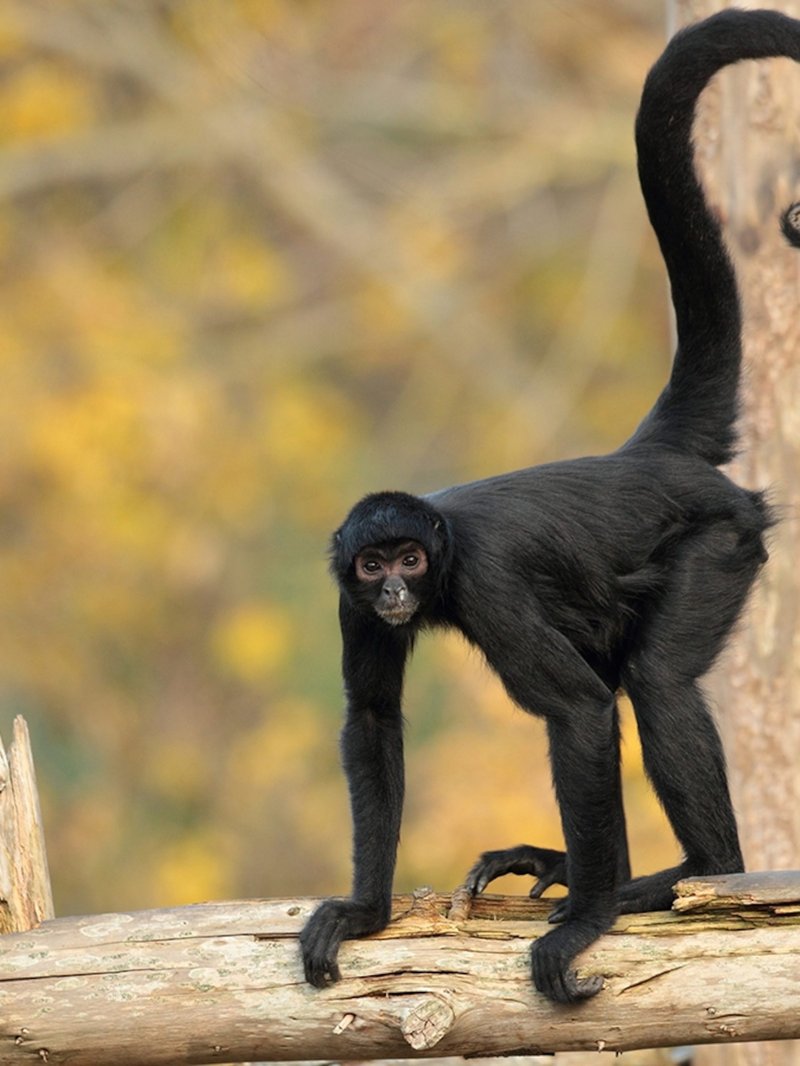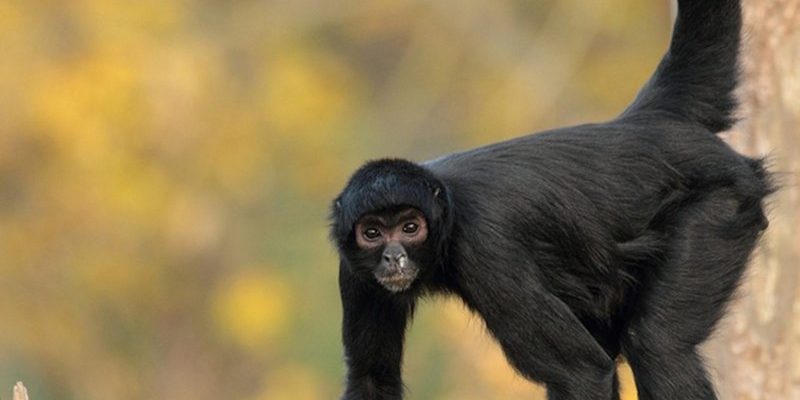
First off, spider monkeys belong to the Atelidae family, which includes several other monkey species known for their prehensile tails and social nature. Unlike other monkeys, which may seem more familiar, spider monkeys are known for their distinctive look, with long limbs and a slender body that almost resembles a dancer in motion. Now, let’s swing into some captivating facts about these remarkable primates!
1. Uniquely Designed Bodies
Spider monkeys have a very special physique that sets them apart from other monkeys. Their long, thin arms and legs help them move gracefully through the canopy. Imagine a diver preparing for a dive; that’s how they grasp branches, swinging and flipping with ease. Their prehensile tail is like a fifth limb, allowing them to grasp objects while they balance on tree branches. This tail is not just for show—it’s incredibly strong and dexterous, making them excellent at navigating their high-altitude homes.
Not only do their bodies help them swing effectively, but spider monkeys also exhibit sexual dimorphism. This means males and females have distinct physical differences. For instance, males are typically larger than females and have broader shoulders. This feature might not be super noticeable at first glance, but it plays a role in their social structure.
2. Social Creatures
Spider monkeys are incredibly social animals. They live in large groups called troops, which can consist of anywhere from 15 to 30 individuals. This group dynamic helps with foraging and protecting against predators. You could think of them as a close-knit family that looks out for one another. Within these troops, they have a fission-fusion society, meaning the troop can split into smaller subgroups for feeding and then come back together later.
Their interactions are filled with vocalizations and grooming. Yes, just like us, they enjoy social bonding! Grooming not only helps keep their fur clean but also strengthens social ties. Imagine the bonding that happens during a family hair-braiding session—it’s a similar concept, fostering connections and building trust.
3. Diet and Feeding Habits
You might be wondering what spider monkeys eat. Well, they primarily feast on fruits, nuts, and leaves. They have a particular preference for ripe fruits, which can be found high up in the trees of their rainforest homes. Their dietary habits make them essential for seed dispersal. Many of the fruits they consume depend on spider monkeys for planting, as they help spread seeds throughout the forest.
But here’s the catch—they are also quite picky eaters! Spider monkeys can spend a lot of time selecting the best fruits to munch on. Think of it like choosing the ripest, juiciest strawberries at the market. This selectivity means that if their preferred food sources become scarce due to deforestation or environmental changes, it can seriously impact their survival.
4. Communication Styles
How do spider monkeys communicate? Their vocalizations are quite diverse. They use different sounds to convey messages, whether it’s a warning about predators or a call to find other members of their troop. Their vocal sounds range from high-pitched cries to deep, booming calls, and each has its purpose.
Imagine if you had a special sound for every situation in your life—how fun would that be? Spider monkeys can also use body language to communicate. For example, they might show their teeth when feeling threatened or puff up to assert dominance. These signals help maintain order within their social structure.
5. Prehensile Tails: Nature’s Grasping Hand
One of the most fascinating features of spider monkeys is their prehensile tail. This tail acts almost like an extra hand! With a strong grip and flexibility, it’s crucial for their survival in the trees. Spider monkeys can wrap their tails around branches to stabilize themselves while reaching for food.
Just picture a tightrope walker using a balancing pole for support—this is how spider monkeys use their tails! This adaptability helps them maneuver through their high-altitude habitats, making them some of the best tree dwellers in their ecosystem. However, their reliance on such a tail also highlights the importance of their arboreal habitat. If their environment is threatened, it greatly impacts their ability to thrive.
6. Threats and Conservation Status
Unfortunately, spider monkeys face several threats in the wild. Habitat loss is their biggest enemy, primarily due to deforestation, agriculture, and logging. As more trees are cut down, their homes shrink, pushing them into smaller areas and making it harder to find food.
Additionally, they are sometimes hunted for bushmeat or captured for the illegal pet trade. The situation is dire for many species of spider monkeys, and they are classified as endangered. Conservation efforts are vital to ensure that these incredible creatures continue to thrive in their natural habitat. Local organizations are working hard to protect their rainforests, educate the public, and promote sustainable practices.
7. Unique Locomotion
When it comes to moving around, spider monkeys have a unique style that sets them apart from other primates. They use a form of locomotion called brachiation, which involves swinging from branch to branch using only their arms. Think of it like a game of tag in the trees, where agility and speed are key!
Their long limbs and flexible joints allow for greater reach, making them quite efficient at navigating their leafy environments. In fact, they can travel up to 30 feet in a single swing! This method of movement not only looks cool but is also essential for escaping predators quickly.
8. Lifespan and Reproduction
Spider monkeys have a relatively long lifespan compared to other primate species. In the wild, they can live up to 20 years, while in captivity, they may live even longer, sometimes reaching 30 years. This longevity is partly due to their social structures and the care they receive in protected environments.
When it comes to reproduction, female spider monkeys usually give birth to one offspring every three to four years. This slow reproductive rate makes it even more crucial for their populations to remain stable. A baby spider monkey clings to its mother’s back for several months after birth, fostering a strong bond that lasts throughout their early life.
9. Spider Monkey Species
Did you know there are several species of spider monkeys? The most well-known species include the black spider monkey, the brown spider monkey, and the red spider monkey. Each type has its own unique traits and habitats. For example, the red spider monkey is known for its vibrant fur and is found primarily in South America, while the black spider monkey is known for its striking black coat.
Each species plays a vital role in its ecosystem, and understanding the differences helps conservationists target efforts more effectively. Recognizing and protecting each species is essential for maintaining biodiversity in their habitats.
10. Cultural Significance
Spider monkeys hold cultural significance in many indigenous cultures across Central and South America. They’ve been featured in folklore and stories, often symbolizing agility and intelligence. In some cultures, they represent the spirit of the forest, emphasizing the relationship between nature and humanity.
These cultural connections remind us of the importance of conserving their habitats. By protecting spider monkeys and their ecosystems, we also safeguard the traditions and stories tied to them for future generations.
In conclusion, spider monkeys are not just fascinating creatures; they are essential elements of their ecosystems, highlighting the complex relationships in nature. Understanding these incredible animals helps us appreciate the importance of conservation efforts to protect them. So, the next time you think about spider monkeys, remember their unique adaptations, social structures, and the challenges they face. Their survival is intertwined with the health of their rainforest homes, and it’s up to us to ensure they continue to swing freely among the treetops for years to come.

